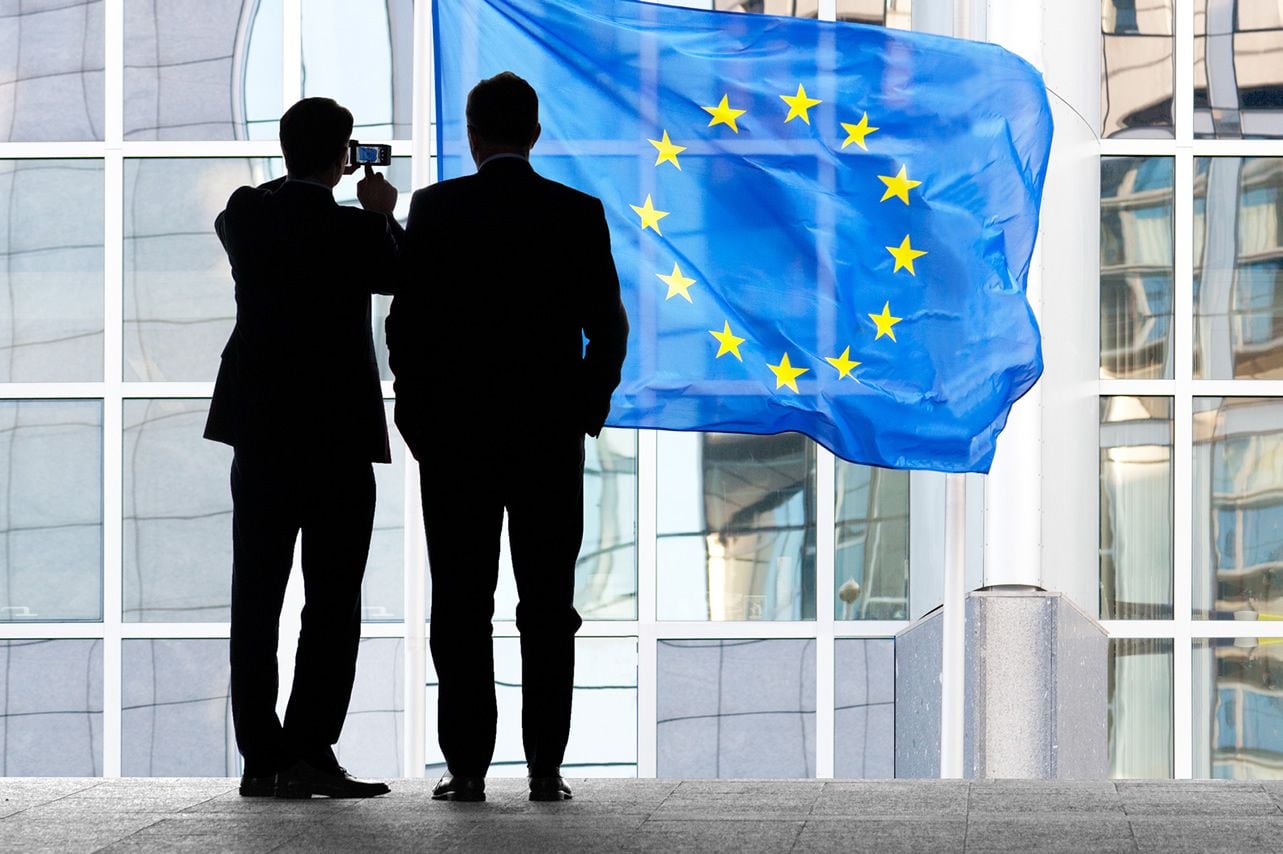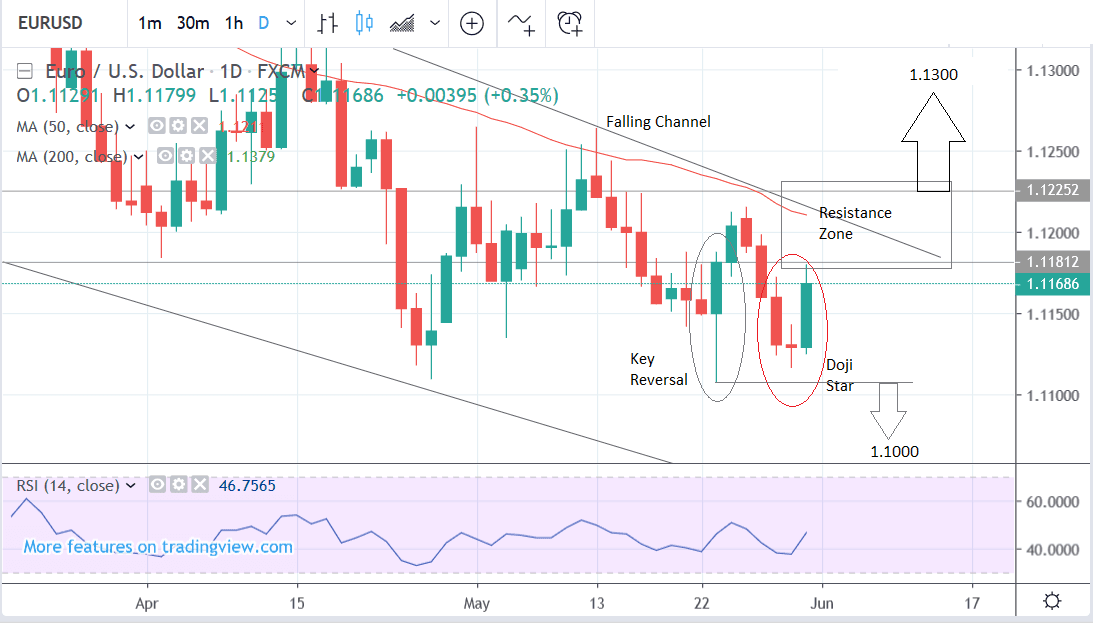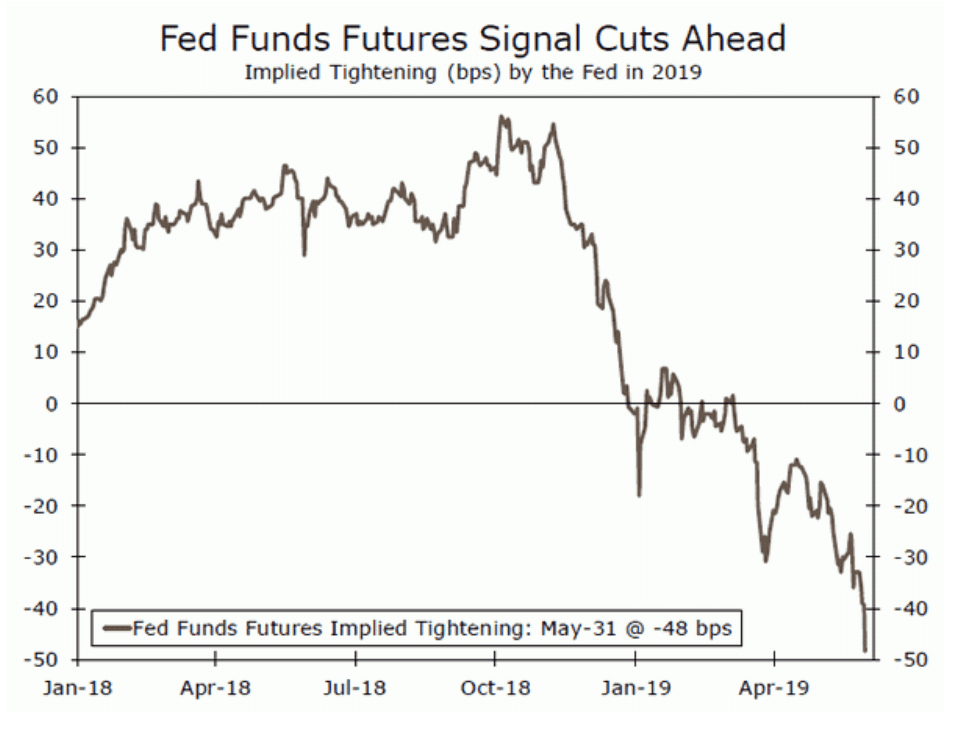EUR/USD 5-Day Forecast: Increasing Hints of Reversal Potential

Image © Adobe Images
- Pair has formed several reversal candlestick patterns
- EUR/USD showing hints of bullishness but lacks confirmation
- Euro driven by ECB; U.S. Dollar by Fed commentary
The Euro-to-Dollar exchange rate is trading at 1.1168 at the start of the new trading week, a third of a percent lower than the week before.
The pair has endured yet another volatile week in which it declined almost back down to the 1.1107 lows but then recovered right at the end, just like it did on the previous Friday.
Initial weakness from the Euro on a continued subdued outlook for the Eurozone economy was finally replaced by Dollar-weakness after president Trump threatened Mexico with tariffs.
From a technical perspective, the broad downtrend remains intact despite increasing signs we may be witnessing a major bottom in the pair. We remain marginally bearish because the trend trumps all other considerations, however, we are only bearish on the condition that the market breaks to new lows. There are multiple signs the market could be forming a major long-term floor and be about to rally - so bears beware!
Whilst it is still too soon to be sure, the 1.1107 lows of May 23 could be a long-term floor. On that day the pair also rallied strongly and in the end formed a strong bullish long term reversal bar called a ‘key reversal’, which we discussed in detail last week.
This pattern usually only occurs when the market makes a major high or low. As we discussed in last week’s piece these patterns can occur at market tops and a bearish variation formed on the S&P500 U.S. equities Index at the top of the market in 2007 just before the great financial crisis.
Although EUR/USD didn’t follow-through to the upside very strongly last week, and almost fell back down to below the May 23 lows, it didn’t break below them, and we are only bearish on the condition the market breaches the bottom of the key reversal. If this were the case it would invalidate the signal and indicate a probable move down to the next target the 1.1000 level.
EUR/USD is showing other signs of technical strength, for example, over the last three days of last week when the market bottomed and turned around the pair formed a bullish ‘doji star’ Japanese candlestick reversal pattern (circled in red), which suggests the market could go higher at the start of next week. This occurs when the market falls in a long red down-day, bottoms in a small indecisive cross-shaped candle, and then rises on the day after in a long, strong, green up-day.
The RSI momentum indicator in the lower panel is also looking quite bullish after having formed what looks like a sort of multiple bottoming pattern or inverse H&S pattern in momentum (circled).
Despite these compelling bullish reversal signals, more confirmation is needed to corroborate the upside thesis. There is also much tough resistance just above the current market level, starting with a monthly pivot (PP) at 1.1180, the 50-day MA at 1.1211, and the upper channel line at circa 1.1225. All these are likely to impede upside progress and would need to be ‘vaulted’ for us to really have faith a new uptrend was taking root.
As such we would ideally wish to see a break above 1.1250, especially a daily close above that level, to be convinced of further upside. If that were so it would open the way for a breakout move higher up to a target at 1.1330, which is based on the height of the channel extrapolated higher.
Time to move your money? Get 3-5% more currency than your bank would offer by using the services of foreign exchange specialists at RationalFX. A specialist broker can deliver you an exchange rate closer to the real market rate, thereby saving you substantial quantities of currency. Find out more here.
* Advertisement
The Euro this Week: ECB Dominates

The main event for the Euro is the meeting of the European Central Bank (ECB) on Thursday, June 6 at 12.45 BST. The ECB’s assessment of the economy, its intentions for monetary policy and the level at which it intends to set interest rates is a big driver for the Euro.
The ECB is widely anticipated to make changes the parameters of its cheap loan programme to Eurozone banks, or TLTRO - ‘targeted long-term refinancing operation’ - programme. Simply put, this provides Eurozone banks with cheap liquidity to help stimulate lending to the wider economy. TLTROs are already in operation but instead of discontinuing them the ECB has decided to extend them.
From a currency perspective, easing policies at the ECB keep the Euro under pressure, only when the ECB reverses direction and withdraws stimulus would we expect a substantial and sustainable rise in the value of the currency.
Markets are continually looking for hints as to when that might happen.
The market is unlikely to react much to the announcement as it has been widely telegraphed already, and priced in. It is only in the event that the ECB does not implement TLTROs, for some reason, that the market might react, by pushing the Euro higher, for example, however, this is unlikely.
The other focus of the meeting will be what Mario Draghi says about the economic outlook in the press conference that follows, as well as the wording of the ECB’s official statement on the state of the Eurozone economy and outlook for monetary policy.
In March, the ECB rowed back on its promise to raise rates in 2019 due to the economic slowdown. It now remains to be seen whether the ECB will provide any further guidance. Any suggestion of an even longer delay than that expected by the market of 2020, could lead to a sell-off in the Euro.
This outcome seems unlikely, though, according to analysts at Wells Fargo, who see the economy as having stabilised, and therefore the ECB not likely to consider further easing.
“The economy has not weakened enough to warrant a full reversal into an easing cycle, but it remains a way off from the first rate hike. Our expectation is for the ECB’s policy rates to remain on hold for the remainder of the year, but gradually exit negative territory in 2020,” says Wells Fargo in a preview note.
The ECB probably has more of an incentive to play down any negatives about the outlook at its meeting. Last week German bond yields fell to record lows on the back of large safe-haven inflows after the U.S. president Trump threatened Mexico with tariffs.
Given its commitment to financial stability, the ECB is unlikely to want to drive yields any lower by issuing a negative assessment, as this could create risks of volatility from an asset bubble.
On the hard data front, the other main events for the Euro are the release of unemployment data and inflation data on Tuesday, at 10.00 BST.
Unemployment is likely to remain unchanged at 7.7%, according to consensus estimates; CPI is expected to fall to 1.3% in May compared to a year ago, from 1.7% in April.
A deeper-than-expected slowdown, however, would probably be negative for the Euro as it would suggest even lower demand from consumers, reflective of a slowing economy, and therefore, raise the possibility of more help needed from the ECB easing monetary conditions.
The U.S. Dollar: Data and Events to Watch

Perhaps the main event for the U.S. Dollar in the week ahead is commentary from Federal Reserve (Fed) Chairman Jerome Powell, who is scheduled to speak at an event in Chicago on June 4th and 5th (Tuesday and Wednesday respectively), and is likely to mention the outlook for Fed policy.
Fed policy impacts on the Dollar via interest rates which it sets. Interest rates are positively correlated to the currency. When interest rates rise it increase foreign capital inflows driving up demand for the Dollar and vice versa for when they fall.
Currently, the Fed has been sticking to a neutral wait-and-see stance in relation to interest rates but the market is a lot more pessimistic expecting almost two 0.25% cuts.
The chart below illustrates this graphically using Fed Fund’s futures which price the probability of interest rates going up or down and therefore provide a useful forecasting tool. They show the market thinks rates should be half a percent lower (50 basis points) then the current 2.50%.
This wide a divergence between what the market expects and what the Fed expects is rare and unlikely to persist. The question is, which will adjust to close the gap? Will the Fed capitulate and become more pessimistic in line with the market or vice versa?
Analysts at Wells Fargo seems to think the market is onto something suggesting the adjustment could come from the Fed. The Fed’s favoured inflation gauge is the Core PCE and this is down at 1.6%, which is lower than the Fed’s 2.0% inflation target, and suggests the Fed may cut rates.
“With trade risks becoming increasingly important to the outlook and inflation remaining comfortably south of the Fed’s 2% target, the Fed may need less of a reason to move from its patient stance, and cut rates earlier than currently expected,” says Wells Fargo in an economic briefing note.
Another threat to the Dollar could come from trade risks as it is becoming increasingly clear that president Trump is using tariffs as a tool with which to threaten neighbours, such as Mexico, who he threatened last week because of lax border control.
This resulted in a tumble in yields and an inversion of the yield curve, which is a reliable early warning of recession. The inversion happens when shorter-term interest rates rise above longer-term interest rates. This is the opposite from the usual state of affairs when investors are compensated with higher interest rates on longer-term interest rates due to the risk of inflation eroding their capital.
On the data from the main releases are the ISM Manufacturing and Non-Manufacturing ISM surveys on Monday, June 3 at 15.00 BST and the Non-Farm Payrolls report on Friday at 13.30.
The most likely market mover of the above is the employment report, more specifically average earnings which need to stay high in order to drive inflation and stave off Fed rate cuts.
Currently, the market is expecting earnings to remain at a 3.2% growth rate, which is “not high enough to drive inflation,” according to Raffi Boyadijian, an economist at broker XM.com.
The risk is they undershoot that, which could weigh on the U.S. Dollar by dampening the inflation outlook and therefore the outlook for interest rates.
Time to move your money? Get 3-5% more currency than your bank would offer by using the services of foreign exchange specialists at RationalFX. A specialist broker can deliver you an exchange rate closer to the real market rate, thereby saving you substantial quantities of currency. Find out more here.
* Advertisement







